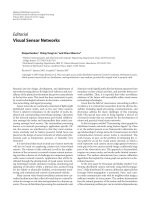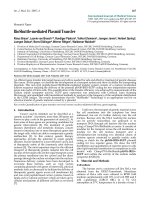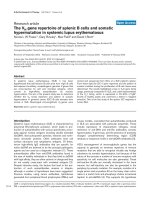Báo cáo y học: " Elucidating developmental gene networks" pot
Bạn đang xem bản rút gọn của tài liệu. Xem và tải ngay bản đầy đủ của tài liệu tại đây (55.74 KB, 3 trang )
Genome
BBiioollooggyy
2008,
99::
310
Meeting report
EElluucciiddaattiinngg ddeevveellooppmmeennttaall ggeennee nneettwwoorrkkss
Anja Hanisch*, Annalisa Vezzaro
†
and Charalampos Rallis
†
Addresses: *Vertebrate Development Laboratory and
†
Developmental Genetics Laboratory, London Research Institute, Cancer Research UK,
London WC2A 3PX, UK.
Correspondence: Charalampos Rallis. Email:
Published: 2 June 2008
Genome
BBiioollooggyy
2008,
99::
310 (doi:10.1186/gb-2008-9-6-310)
The electronic version of this article is the complete one and can be
found online at />© 2008 BioMed Central Ltd
A report on the Joint Meeting of the British Societies for Cell
and Developmental Biology, Warwick, UK, 31 March-3 April,
2008.
This year’s annual meeting of the British Societies for Cell
and Developmental Biology focused on several aspects of
signaling mechanisms and gene and protein networks in
relation to cell architecture, animal and plant development
and evolution. Here, we summarize some highlights on mor-
phogen gradients, mouse embryo genetic manipulations,
stem-cell biology and evolution and gene networks during
evolution and development.
TTrraacckkiinngg mmoorrpphhooggeenn ggrraaddiieennttss
One way of establishing positional information within the
developing embryo is through the graded distribution of a
morphogen, a molecule that has the ability to specify cell
fate. Gradients of transforming growth factor-β (TGF-β)
family members such as activin are involved in the establish-
ment of the three germ layers (endoderm, mesoderm and
ectoderm). Jim Smith (Wellcome Trust/Cancer Research UK
Gurdon Institute, UK) described the work of his group to
visualize the formation of a gradient of TGF-β signaling in
gastrulating embryos. They used the technique of biomole-
cular fluorescence complementation (BiMC) to follow the
formation of the heterodimer of the transcription factors
Smad2 and Smad4, the outcome of TGF-β-type signaling.
The amino-terminal half of the fluorescent protein Venus is
fused to Smad2 and the carboxy-terminal half of the protein
is fused to Smad4. On addition of activin and formation of
the Smad2-Smad4 complex the two parts of Venus come
together, generating a complete fluorescent protein. In
cultured cells, the more activin is added, the more fluores-
cence is accumulated in the nucleus, showing that the assay
can provide a quantitative analysis. Using BiFC in Xenopus
and zebrafish embryos, Smith and colleagues were able to
visualize the formation of a Smad signaling gradient in vivo
and the spreading of the gradient over time. Their results
provide evidence that such gradients are required for the
correct dorso-ventral patterning of the early zebrafish embryo.
The protein Sonic hedgehog (Shh) is indispensable for
normal development and mutations in components of its
signaling pathway are also linked to cancer. Shh acts as a
morphogen in a concentration-dependent manner and
regulates the dorso-ventral patterning of the neural tube and
the antero-posterior patterning of the vertebrate limb. David
Martinelli (Johns Hopkins University, Baltimore, USA)
presented results on Gas1, a 37 kD membrane-anchored
protein present in all vertebrates. Studies in NIH 3T3 fibro-
blasts in culture showed that Gas1 enhances Shh signaling
activity, and genetic evidence from mouse mutants showed
that Gas1 facilitates Shh signaling in all developmental
contexts examined, such as the neural tube, limbs and
craniofacial area. Studies in chicken neural tube showed that
Gas1 acts in a cell-autonomous manner to fine tune the Shh
activity gradient, and that in the dorsal neural tube Gas1
expression is restricted via Shh signaling, thus providing a
self-limiting mechanism of Shh signaling. The results
support a model in which Gas1 acts cooperatively with the
receptor of Shh, Patched1, to transform the Shh protein
gradient into an activity gradient.
The Fox proteins are a family of highly conserved trans-
cription factors that control a wide spectrum of biological
processes during development. Catarina Cruz (National
Institute for Medical Research, London, UK) found Foxj1 in a
microarray-based expression screen for Shh-regulated genes
in the chick neural tube. Foxj1 expression is restricted to cells
of the ventrally located floor plate in the developing neural
tube, and Shh is both necessary and sufficient for expression.
Foxj1 is associated with the generation of long, possibly
motile, cilia on floor-plate cells, which are morphologically
distinct from the primary cilia found elsewhere in the neural
tube. Overexpression of Foxj1 in non-floorplate cells was
sufficient to induce cilia with floor-plate-like characteristics.
Foxj1 decreases the responsiveness of neural cells to Shh
signaling, and consistent with this, Foxj1 repressed genes
that require high levels of Shh signaling for their expression,
such as Nkx2.2. These results indicate that Foxj1 is a Shh-
regulated gene in the neural tube that induces changes in the
ciliogenesis program of neural cells and may modulate how
these cells respond to Shh.
GGeenneettiicc iinntteerrvveennttiioonn iinn ssiiggnnaalliinngg ppaatthhwwaayyss
The enteric nervous system controls the contractility of the
gut and is a vast network of neurons derived from neural
crest cells (NCCs). NCCs migrating from vagal and sacral
regions of the embryo colonize the whole length of the gut.
Hirschsprung’s disease is a congenital disorder affecting 1 in
5,000 newborns that is characterized by the absence or
reduction of NCC-derived enteric ganglia in a variable
portion of the distal gastrointestinal tract. Most familial
cases are related to mutations in the receptor-type tyrosine
kinase RET. RET has two major isoforms, RET9 and RET51.
Vassilis Pachnis (National Institute for Medical Research,
UK) reported work by his group to determine the roles of
these isoforms in vivo by generating mice that expressed
either RET9 or RET51 only. RET9-only mice were viable and
normal, but mice lacking RET9 did not develop enteric
ganglia in the colon, phenocopying Hirschsprung’s disease.
Interestingly, these mice showed additional defects in
neuronal differentiation in the gut, which have not been
reported before and might have implications for the future
treatment of the disease. Pachnis also reported the isolation,
culture and molecular characterization of enteric nervous
system progenitor cells. When transplanted into mouse
embryos in utero, these cells are able to survive, migrate and
integrate into the enteric nervous system.
The ability of current conditional knock-out and knock-in
strategies to define the temporal requirements for a protein’s
function during development are limited. To lift this
constraint, Karen Liu (King’s College London, UK) has
engineered a widely applicable technology based on fusing
the protein of interest to an 89 amino-acid tag called FRB*
that confers instability. Stabilization, and thus restoration of
protein level and activity, can be induced by addition of
rapamycin, which enables the dimerization of FRB* with the
cytoplasmic protein FKBP, a member of the immunophilin
family of proteins that function as protein folding
chaperones. She reported that mice with the rapamycin-
dependent allele GSK3β
FRB*/FRB*
displayed defects identical
to GSK3β-null mice, and that these mutant phenotypes
could be rescued if rapamycin was applied in the critical
time window in which the protein function was needed. The
rapamycin-induced protein stabilization can be reversed by
a competitive inhibitor. Liu also reported an application of
the technique to control the nuclear export of transcription
factors: the transcription factor is tagged with FRB* and
expressed together with a fusion of FKBP and a nuclear
export signal (FKBP-NES). Dimerization of the FRB*-tagged
transcription factor and FKBP-NES, and thus the cellular
localization of the transcription factor, can be tightly
controlled by the experimenter by the addition of rapamycin
or a competitive inhibitor.
AAddvvaanncceess iinn mmaammmmaalliiaann,, iinnvveerrtteebbrraattee aanndd ppllaanntt sstteemm
cceellll ssyysstteemmss
Within a population of embryonic stem (ES) cells cultured
under seemingly homogenous conditions, the majority will
differentiate into neural cells upon withdrawal of self-
renewal stimuli; the remaining cells, however, will either not
respond to the differentiation cues or will respond differently,
creating non-neural, mesodermal progenitors. Successful
application of ES cell-based technology critically depends on
suppressing such diversity and precisely controlling lineage
commitment. Sally Lowell (University of Edinburgh, UK)
focused on efforts to understand the mechanism that under-
lies inappropriate non-neural differentiation of cultured ES
cells. Previous experiments have shown that Notch
signaling, a conserved intercellular pathway that mediates
lateral inhibition among neighboring cells, biases pluri-
potent ES cells towards the neural lineage. Lowell presented
evidence that Notch signaling exerts its effect via its target,
Hes1, by amplifying in a cell-autonomous manner the LIF/
STAT3 signaling pathway, which is known to maintain
pluripotency and self-renewal of ES cells in culture. In line
with this, she reported that both Hes1 and phosphorylated
STAT3 show a variable expression pattern in ES cell cultures.
She also showed that active Notch signaling increases STAT3
promoter activity, and that overexpression of its direct target
Hes1 increases the proportion of ES cells with activated
STAT3; in this way pluripotent ES cells could be specifically
blocked from entering the non-neural, mesodermal lineage.
Amputated planarians show an amazing capacity to regenerate
a perfect head or tail. Alejandro Sanchez Alvarado (Univer-
sity of Utah, Salt Lake City, USA) revealed β-catenin as a
molecular switch for specifying and maintaining anterior-
posterior polarity in planarians during both regeneration
and tissue homeostasis. Decreasing Wnt signaling by RNA
interference (RNAi) of β-catenin or Dishevelled (compo-
nents of the Wnt signaling pathway) followed by simul-
taneous head and tail amputations resulted in the regenera-
tion of two heads, whereas increasing Wnt signaling by RNAi
of APC1 (which inhibits β-catenin activation) gave rise to
animals with two tails. Remarkably, RNAi against β-catenin
itself was sufficient to induce formation of ectopic head-like
structures in unamputated animals. The regeneration poten-
tial in planarians resides in numerous stem cells, which are
spread throughout the body and need to be tightly controlled
for normal tissue homeostasis. Alvarado also showed that
/>Genome
BBiioollooggyy
2008, Volume 9, Issue 6, Article 310 Hanisch
et al.
310.2
Genome
BBiioollooggyy
2008,
99::
310
depletion of the planarian homolog of the human tumor
suppressor gene PTEN is lethal as a result of overprolifera-
tion of stem cells and the resulting formation of functionally
disrupted tissues.
Ben Scheres (Utrecht University, the Netherlands) presented
recent work on the positioning and specification of stem-cell
centers during embryogenesis or regeneration in the plant
Arabidopsis thaliana. In roots, the maximum response to
the plant hormone auxin is in the stem-cell niche, whereas a
low auxin concentration is observed in the transit-amplify-
ing cells that derive from the stem cells and will go on to
differentiate. Scheres reported that auxin induces four
PLETHORA (PLT) genes that encode AP2-domain contain-
ing transcription factors essential for root stem-cell speci-
fication. The PLT genes regulate the expression of the PIN
membrane proteins that are polarized on cells and facilitate
polarized auxin transport in the root. During regeneration of
the root stem-cell niche after laser ablation, PIN proteins
continuously transport auxin into the area. The high levels of
auxin drive neighboring cells to organize and regenerate the
root stem-cell niche and growth of the plant continues. PIN-
mediated auxin accumulation also positions the shoot organ
primordia. Scheres also showed that shoot-specific PLT
mutants affect shoot organ positioning, demonstrating that
PLT and PIN regulatory loops are conserved and function in
both roots and shoots.
GGeennee rreegguullaattiioonn aanndd eevvoolluuttiioonn
Binding of transcription factors to noncoding DNA sequen-
ces that act as cis-regulatory modules contributes to spatial
and temporal regulation of gene expression during verte-
brate development. Greg Elgar (Queen Mary, London, UK)
combines in vivo functional assays, molecular biology and
bioinformatics to explore the function of highly conserved
noncoding elements (CNEs) in the vertebrate genome. He
reported a comparison of the genome of the pufferfish Fugu
rubripes with those of mammals that identified 1,400 CNEs
that are likely to function as regulatory elements, many of
them organized in clusters in the vicinity of genes encoding
known developmental regulators. His group has developed
functional in vivo assays to investigate the enhancer activity
of these CNEs. Candidate CNEs were amplified by PCR and
co-injected into zebrafish embryos with a green fluorescent
protein (GFP) reporter construct under the control of a
β-globin minimal promoter; the embryos were then screened
at different developmental stages for GFP expression. Many
of the CNEs tested were able to spatially and temporally up-
regulate GFP expression, although their molecular mecha-
nism of action remains elusive. The CNEs and the results of
the in vivo assays can be accessed in the database CONDOR
[].
Sean Carroll (University of Wisconsin, Madison, USA) and
colleagues want to understand the mechanisms contributing
to the evolution of form. Extensive evidence shows that
changes in animal form result from alterations in the spatial
pattern of gene expression, but the way these changes have
evolved is unclear. Carroll argued that evolution of cis-
regulatory sequences is the major contributor to evolution of
form. He pointed out that in contrast to alterations in coding
sequences, effects of changes in modular cis-regulatory
sequences are minimally pleiotropic, and illustrated this by
considering the diversity of pigmentation in Drosophila
species. For example, Drosophila santomea differs from
D. yakuba in loss of abdominal pigmentation due to
mutations in a cis-regulatory element controlling expression
of the pigmentation gene tan. Similarly, a successive gain of
cis-regulatory modules for both transcriptional repressors
and activators has produced the pigment spot in the wing of
D. biarmipes, a species closely related to D. melanogaster
(which has no spot). These data demonstrate that changes in
cis-regulatory sequences provide a mechanism to explain
evolution of form.
Overall, the meeting highlighted many advances and
approaches in different areas of cell and developmental
biology, and we look forward to more.
AAcckknnoowwlleeddggeemmeennttss
We thank the speakers for comments on the manuscript and Cancer
Research UK for providing us with funds towards the cost of attending
the meeting.
/>Genome
BBiioollooggyy
2008, Volume 9, Issue 6, Article 310 Hanisch
et al.
310.3
Genome
BBiioollooggyy
2008,
99::
310









